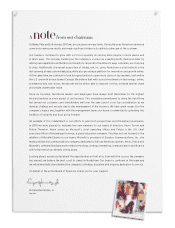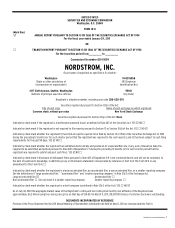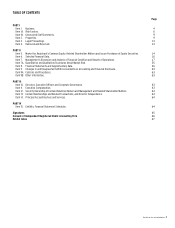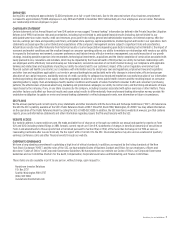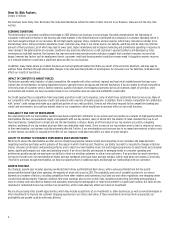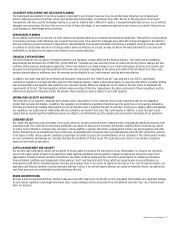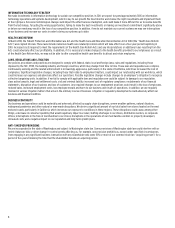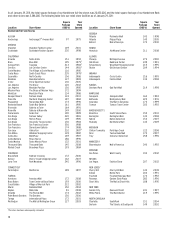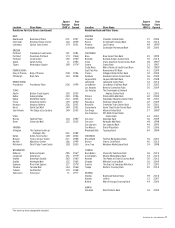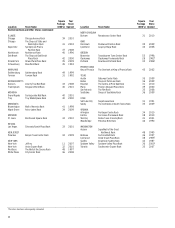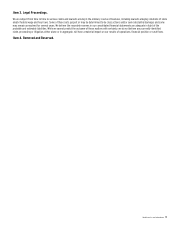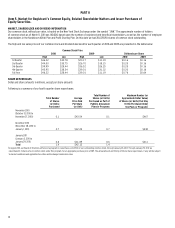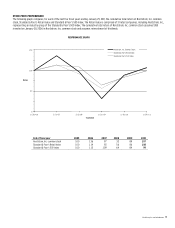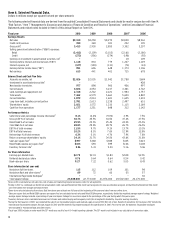Nordstrom 2010 Annual Report Download - page 16
Download and view the complete annual report
Please find page 16 of the 2010 Nordstrom annual report below. You can navigate through the pages in the report by either clicking on the pages listed below, or by using the keyword search tool below to find specific information within the annual report.8
INFORMATION TECHNOLOGY STRATEGY
We make investments in information technology to sustain our competitive position. In 2011, we expect to spend approximately $185 on information
technology operations and systems development, which is key to our growth. We must monitor and choose the right investments and implement them
at the right pace. Excessive technological change could impact the effectiveness of adoption, and could make it more difficult for us to realize benefits
from the technology. Targeting the wrong opportunities, failing to make the best investments or making an investment commitment significantly above
or below our needs may result in the loss of our competitive position. In addition, if we do not maintain our current systems we may see interruptions
to our business and increase our costs in order to bring our systems up to date.
HEALTH CARE REFORM
In March 2010, the Patient Protection and Affordable Care Act and the Health Care and Education Reconciliation Act of 2010 (the “Health Care Reform
Acts”) were signed into law. These laws include numerous health care related provisions which will take effect over a four year period beginning in
2010. Increased costs required to meet the requirements of the Health Care Reform Acts and any interpretations or additional rules resulting from the
Acts could adversely affect our profitability. In addition, if it is necessary to make changes to the health benefits provided to our employees as a result
of the Health Care Reform Acts, we may not be able to offer competitive health care benefits to attract and retain employees.
LAWS, REGULATIONS AND LITIGATION
Our policies, procedures and practices are designed to comply with federal, state, local and foreign laws, rules and regulations, including those
imposed by the SEC, NYSE, the banking industry and foreign countries, which may change from time to time. These laws and regulations are complex,
continuously evolving and the related enforcement is increasingly aggressive, particularly in the state of California, which has increased the cost of
compliance. Significant legislative changes, including those that relate to employment matters, could impact our relationship with our workforce, which
could increase our expenses and adversely affect our operations. Possible legislative changes include changes to an employer’s obligation to recognize
collective bargaining units. In addition, if we fail to comply with applicable laws and regulations we could be subject to damage to our reputation,
class action lawsuits, legal and settlement costs, civil and criminal liability, increased cost of regulatory compliance, restatements of our financial
statements, disruption of our business and loss of customers. Any required changes to our employment practices could result in the loss of employees,
reduced sales, increased employment costs, low employee morale and harm to our business and results of operations. In addition, we are regularly
involved in various litigation matters that arise in the ordinary course of business. Litigation or regulatory developments could adversely affect our
business and financial condition.
BUSINESS CONTINUITY
Our business and operations could be materially and adversely affected by supply chain disruptions, severe weather patterns, natural disasters,
widespread pandemics and other natural or man-made disruptions. We derive a significant amount of our total sales from stores located on the west
and east coasts, particularly in California, which increases our exposure to conditions in these regions. These disruptions could cause, among other
things, a decrease in consumer spending that would negatively impact our sales; staffing shortages in our stores, distribution centers, or corporate
offices; interruptions in the flow of merchandise to our stores; disruptions in the operations of our merchandise vendors or property developers;
increased costs; and a negative impact on our reputation and long-term growth plans.
ANTI-TAKEOVER PROVISIONS
We are incorporated in the state of Washington and subject to Washington state law. Some provisions of Washington state law could interfere with or
restrict takeover bids or other change-in-control events affecting us. For example, one provision prohibits us, except under specified circumstances,
from engaging in any significant business transaction with any shareholder who owns 10% or more of our common stock (an “acquiring person”) for a
period of five years following the time that the shareholder became an acquiring person.


